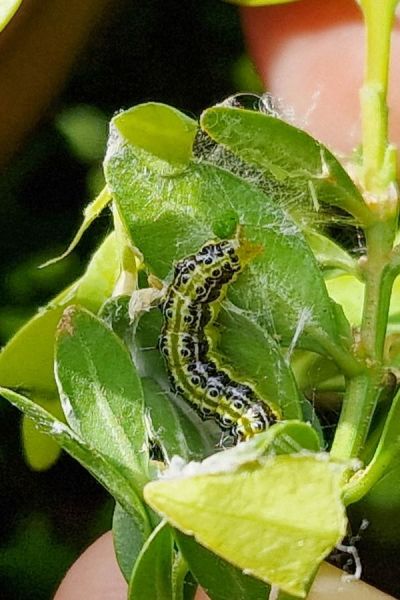How to spot box tree moth caterpillars – the best ways to deal with it!
Box moth caterpillars – also known as box tree moth caterpillars- can strip the leaves from your box plant or hedge.
In extreme cases, your plant will die.
As many of us have box topiary or hedges, this can really affect your garden.
It’s a relatively recent pest and came from Asia via Europe, arriving in the UK in 2007. And it’s spreading fast around the world to the USA, Canada and other places.
This year, I discovered box moth caterpillars on all of my box topiary, including my beloved topiary spiral. This is the most expensive plant in my garden and is also a focal point.

My box topiary spiral in happier times.
How to spot box moth caterpillar damage
The damage starts in spring when the box tree caterpillars appear. They will usually have spent the winter wrapped in their silk webbing, sheltering in your box plant.
As your plants sprout new green growth, you will see darker green or brown-grey patches, where the caterpillar has damaged that new growth.
Go closer and you will see a net of white or silvery webbing with dying foliage, then a caterpillar inside.

Look for patches where there is no new growth (see top photo). When you look closer, you will see dead or dying leaves on these patches. You can see a larger patch in the lower photo.
What do box moth caterpillars look like?
Box moth caterpillars have citrus-green and black stripes, running the length of their body. They have black heads and are usually protected by the fine webbing around them.

The box tree moth caterpillar
What eats box moth caterpillars?
We’re all being encouraged to have wildlife friendly gardens, so that predators can eat up our pests. It makes for easier gardening and is better for the environment.
I recently interviewed Helen Bostock, Senior Wildlife Advisor for the RHS, on gardening for biodiversity. She explained that slugs and snails help our compost heaps work better.
If you have birds and ladybirds, they’ll eat most of your aphids. So, as long as you’re prepared to tolerate some nibbled leaves, then you can put down the chemical sprays and let nature get on with it.
However, no-one suggests you should take that approach for box moth caterpillars. Because they arrived recently, they don’t currently have natural predators in the UK. There have been some early reports of sparrows, starlings and blue tits beginning to feed on them in the UK, but not in sufficient numbers to control the spread.
In Asia, Asian hornets eat box moth caterpillars, but these would cause other problems if we imported them here.
How to get rid of box moth caterpillars
If you don’t want to harm other insects in your garden, you’ll need to control box moth caterpillars with a biological control. You can get nematodes (Nemasys Fruit & Veg is a popular brand for this purpose). Note that links to Amazon are affiliate, see disclosure.
You’ll need to read the instructions on nematodes carefully and follow them precisely. You can’t often store them for long, for example, and you may have to keep them in the fridge.
There is also a product called Top Buxus Xentari, which several professional gardening friends around the world have used successfully. It’s safe for bees and birds.
It’s a bacterial insecticide with an active ingredient based on Bacillus thoringiensis subs Azawai. But it’s not yet licensed for use in the UK, although it is licensed for both amateur and professional use in various countries around the world. So it depends on where you live as to whether anyone is allowed to sell it to you.
You can find a professional treatment by searching online ‘box tree moth professional treatment’. Check that they are using products that minimise damage to other insects or wildlife.
Any insecticide that works against several kinds of pest will probably also affect the natural balance of pests and predators in your garden. So avoid the all-purpose sprays if you can. If you do use one, make sure you use it on a still, dry day so the spray doesn’t drift.
You’ll need to repeat any treatment several times throughout the summer.
Note that links to Amazon are affiliate, see disclosure. Other links are not affiliate.
Prune and feed the box plants
Several professional gardening friends have pointed out that clipping the box means that you’ll be cutting some of the caterpillars off (or cutting them in half). This isn’t a cure, but it’s a useful way of reducing the numbers.
So we’ll clip all our box topiary. Always bag up the clippings and dispose of them – don’t leave them lying around or put them in the compost heap.
I’ve also been advised to feed the plants. Once again, this isn’t a cure, but it’ll help the plants recover faster and should minimise the damage.
Healthy, well established plants always withstand pests and diseases better than plants which are struggling or new, recently planted plants.
Do box moth caterpillars eat other plants?
No, they don’t. If you see caterpillars on your other plants, it’s not the box tree moth caterpillar.
But in the end, don’t plant box plants
Sadly, the best way of avoiding both box moth caterpillars and box blight is to stop planting box.
There may be a blight-resistant box variety in future. And treatments like TopBuxus Xentari will also probably be licensed more widely.
It’s a pity because box is such a brilliant plant, especially for topiary. There’s been much discussion about the best alternatives to box in the gardening world. And everyone has been quite disappointed by the performance of Ilex crenata, the plant that looks most like box.
You can clip conifers into shape, and some naturally have sharp enough shapes to look like topiary. See how conifers can transform your year-round garden.
I’ve also used privet, holm oak and holly in my own garden. I bought them as young plants and had them topiarised which was cheaper than buying them ready-made. See how to buy sensational topiary on a middle-sized budget.
If you’re in the UK and have just spotted box moth caterpillars in your garden, let the RHS know by completing their survey on this page.
Pin to remember how to get rid of box moth caterpillars
And do join us. See here for a free weekly email with more gardening tips, ideas and inspiration.

























Hello, I am from the Czech Republic and I would like to share my experience. I have been using Lepinox Plus for caterpillars for several years. Contains the bacteria Bacillus thuringiensis ssp. kurstaki. The caterpillar eats these bacteria along with the leaves. They stop eating. As a result, it stops receiving fluids and gradually dries up and dies. It takes 1-2 days. It is important to spray the inside of the bushes and not just the surface. A preparation that really works. It must not rain for at least 2 days, the bacteria would be washed away.
I think this is the same active ingredient as in the Xentari, which is licensed for use in Europe but not yet in the UK. However, we are hoping it will be approved soon.
I’ve just ‘saved’ two butterflies from inside the house – only afterwards finding out they were the box moth. Great! Thanks for the article at least I know by more about them now! Lots of them here in Kent.
Yes, they are literally everywhere I see box.
I’ve just video birds feeding on these catapillers in my garden. Yes!
Just watched a whole flock of Sparrows feeding on my Box Hedge. Had noticed it looked like it was dying and thought Blight!! No..Caterpillars..
Well, I’m glad the sparrows are eating them, but sadly, I think that’s the end of box for you. It’s really a shame how it’s spreading because box is otherwise such a good plant.